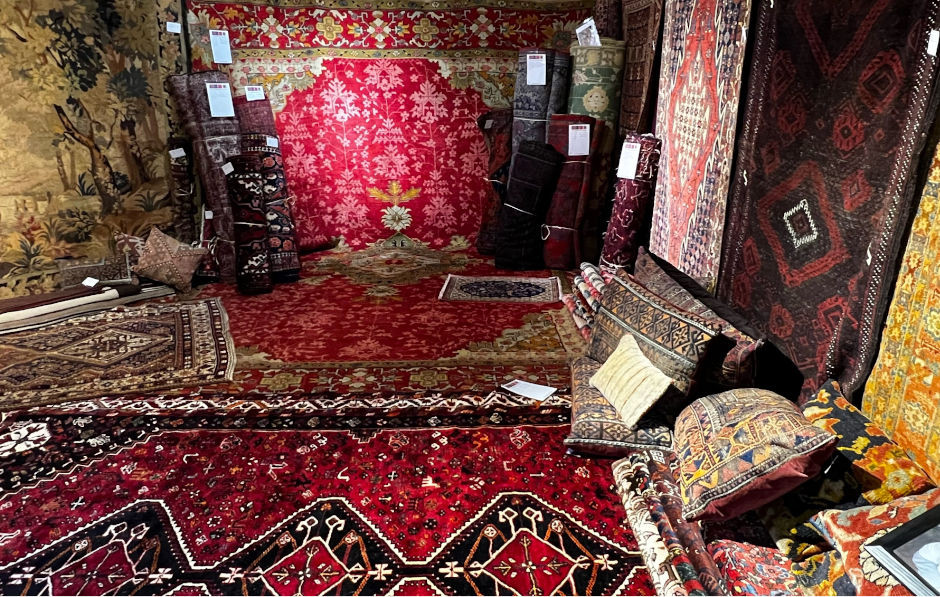
The perfect way to add texture and colour to a room, vintage rugs are as varied as they are beautiful, and in our latest guide we look at characteristics, identification, cleaning and restoration.
How old is a vintage rug?
Vintage tapestries and rugs are generally accepted to be vintage between 50 and 100 years old, with older examples being antique.
How to identify a vintage rug
- Vintage rugs are hand knotted which means patterns are woven by hand into foundation threads stretched across a loom; the foundation threads become the fringing on the finished article. Modern rugs are manufactured using a tufting method. This involves the design being punched through a fabric sheet and the finished rug is then backed with fabric to secure the tufts in place. Consequently, a genuine vintage rug will have no backing and the rear of the rug will be visible.
- Where a rug has fringing, this will be part of the rug’s make-up (see above) – it will not have been sewn on to the finished rug separately.
- Vintage rugs are made from natural materials including wool, silk and cotton. Steer clear of ‘vintage’ rugs manufactured from polyester or acrylic fibres.
- When a damp cloth is pressed against a genuine vintage rug, there will be no colour transfer as the vegetable dyes used in authentic rugs are colourfast.
Understanding the KPI of a vintage rug
KPI refers to the number of knots per inch on a rug. The KPI can be anything between 40 to 400 but on valuable and good quality examples it can be even higher. As a general rule of thumb, the higher the KPI, the higher the density and quality of the rug, which in turn will be reflected in a higher price.
Types of vintage rugs
There are many types of vintage rugs, named for their country or region of origin. The most popular and well-recognised are Persian rugs, and oriental rugs.
Persian rugs
Originating from countries belonging to the old Persian Empire, many Persian rugs come from what is now Iran and Pakistan. Persian rugs are often named after the village, town or city where they were crafted, for example Baluch (sometimes Beluch) rugs are named after the nomadic Afghanistan tribes that produced them while Kashan rugs hail from the city of the same name.
Oriental rugs
The Orient encompassed China, Nepal, India and Tibet with parts of Afghanistan and Pakistan also included which were also part of the Persian Empire.
Kilim rugs
Kilim rugs originate from Turkey and are flat-woven pieces with striking geometric designs created in bright colours. Crafted from wool or cotton, kilim rugs are often used as wall hangings, tablecloths, bed throws and even as fabric for bags and upholstery.
How to care for vintage rugs
It is important to keep vintage rugs clean to keep them looking their best and the simplest way to do this is by vacuuming the rug using a soft brush attachment. If you think this is too harsh for the rug, the traditional method of rug beating is just as effective! Simply hang the rug on an outdoor washing line and gently beat it with a carpet beater.
Try to avoid positioning the rug in direct sunlight as this may fade the colours in the rug.
Where the rug has stains or dirt spots, never attempt to clean the rug yourself as damage can easily be caused, for example by the use of detergent, by scrubbing, or by using water that is too hot. Instead, consult a specialist cleaner who can advise you.
Restoring vintage rugs
If you have a vintage rug in need of restoration, always seek the services of a professional restorer.
Rarely will a professional rug restorer not be able to repair a piece, but sometimes whether you choose restoration will depend on costs. The cost of an extensive restoration project may outstrip the financial value of the rug. However, let’s not confuse financial value and sentimental value as your emotional attachment can sometimes be the deciding factor!
A restorer will have learned their craft over many years and their skillset lies not just in their technical ability but in their understanding of which methods and techniques to use, and when. They will be able to restore a variety of problems, such as repiling worn areas, reweaving holes, and securing edges.
More than anything, a professional restorer will know when a rug simply cannot be restored (for example if there is extensive moth damage or rot) and will be able to advise whether to conserve the rug (secure and stabilise it so that its condition doesn’t worsen) or perhaps even to rework it into something that can still be used and enjoyed, such as soft furnishings or seat covers.
Vintage rugs at Hemswell Antique Centres
Far easier than travelling to a Turkish bazaar to find a vintage rug is a trip to our centres where we have a wide choice of antique rugs for sale. With exquisite examples of the finest Persian, Turkish and oriental rugs, we have a vintage and antique rug dealer in Building 2 and a professional dealer and restorer in The Guardroom. So come along and see for yourself, and while away a few pleasant hours browsing the colours and textures of all our vintage and antique textiles.